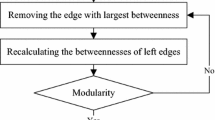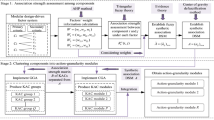Abstract
Module partitioning is beneficial for engineers to gain a better understanding of the structure and function of complex mechanical products (CMPs). It plays an important role in the entire life cycle of the CMPs. However, owing to the large number of mechanical parts and the complex relationships, existing module partition approaches cannot obtain multi-level information. Consequently, the in-depth analysis of CMPs is hindered. Therefore, a novel multi-granularity module partition approach for CMPs based on a complex network (CN-MgMP) is proposed in this paper. Using this approach, a weighted complex network for mechanical parts (MP_WCN) was constructed. The multi-granularity module partition algorithm is presented based on MP_WCN. It consists of three phases. First, based on the concept of modularity increment, the MP_WCN is decomposed into several sub-networks, and fine-grained modules are thus obtained. Next, the topic semantic vectors of these fine-grained modules are extracted using the termfrequency–inversedocumentfrequency (TF-IDF) text analysis method. Finally, taking the global module distance (Glo-MD) as the optimization goal, the fine-grained modules are merged hierarchically to obtain optimal coarse-grained modules. The experimental results for the vertical elevator demonstrate the effectiveness and superiority of the proposed approach.







Similar content being viewed by others
Explore related subjects
Discover the latest articles and news from researchers in related subjects, suggested using machine learning.Data availability
Not applicable.
References
Li YP, Ni YB, Zhang N, Liu ZH (2021) Modularization for the complex product considering the design change requirements. Res Eng Design 32:507–522
Yin XQ, Mo YD, Dong CC, Zhang YH (2020) Identification of the influential parts in a complex mechanical product from a reliability perspective using complex network theory. Qual Reliab Engng Int 36(2):604–622
Li YP, Wang ZT, Zhang L, Chu XN, Xue DY (2017) Function module partition for complex products and systems based on weighted and directed complex networks. J Mech Des 139:021101
Ji YJ, Chen XB, Qi GN, Song LW (2013) Modular design involving effectiveness of multiple phases for product life cycle. Int J Adv Manuf Technol 66:1475–1488
Li YP, Chu XN, Chen DP, Liu QM, Shen J (2015) An integrated module portfolio planning approach for complex products and systems. Int J Comput Integr Manuf 28:988–998
Zhang N, Yang Y, Zheng YJ, Su JF (2019) Module partition of complex mechanical products based on weighted complex networks. J Intell Manuf 30:1973–1998
Xu XM, Zhang WX, Ding XL (2018) Modular design method for filament winding process equipment based on GGA and NSGA-II. Int J Adv Manuf Technol 94:2057–2076
Yang M, Xia YM, Jia LH, Wang DJ, Ji ZY (2021) A modular design method based on TRIZ and AD and its application to cutter changing robot. Adv Mech Eng 13(7):16878140211034369
Ren WB, Wen JQ, Guan Y, Hu YG (2018) Research on assembly module partition for flexible production in mass customization. Procedia CIRP 72:744–749
Liu ZH, Zhang MT, Li YP, Chu XN (2020) Research on the module configuration of complex products considering the evolution of the product family. J Intell Fuzzy Syst 39:4577–4595
Wei W, Zhan Y (2019) Green product module partition method based on improved multi-objective artificial bee colony algorithm. MATEC Web of Conferences 301:00021
Wei W, Liang H, Wuest T, Liu A (2018) A new module partition method based on the criterion and noise functions of robust design. Int J Adv Manuf Technol 94:3275–3285
Li ZK, Cheng ZH, Feng YX, Yang JY (2013) An integrated method for flexible platform modular architecture design. J Eng Des 24:25–44
Li ZK, Wang S, Yin WW (2019) Determining optimal granularity level of modular product with hierarchical clustering and modularity assessment. J Braz Soc Mech Sci Eng 41:342
Li BM, Xie SQ (2015) Module partition for 3D CAD assembly models: a hierarchical clustering method based on component dependencies. Int J Prod Res 53:5224–5240
Li ZK, Wei WY (2022) Modular design for optimum granularity with auto-generated DSM and improved elbow assessment method. Proc Inst Mech Eng Part B-J Eng Manuf 236:413–426
Yin L, Yang F, Zhu F, Qin Q (2022) Research on module partition for remanufacturing parts to be assembled. S Afr J Ind Eng 33:114–125
Xiao LM, Huang GQ, Zhang GB (2022) Toward an action-granularity-oriented modularization strategy for complex mechanical products using a hybrid GGA-CGA method. Neural Comput Appl 34:6453–6487
Weng LW, Hu YW, Deng YM (2021) Functional combination-oriented module identification for adaptable-function mechanical product design. Int J Adv Manuf Technol 116:523–536
Samarasinghe T, Gunawardena T, Mendis P, Sofi M, Aye L (2019) Dependency structure matrix and hierarchical clustering based algorithm for optimum module identification in MEP systems. Autom Constr 104:153–178
Sinha K, Han SY, Suh ES (2019) Design structure matrix-based modularization approach for complex systems with multiple design constraints. Syst Eng 23(2):211–220
Li YP, Chu XN, Chu DX, Liu QM (2014) An integrated module partition approach for complex products and systems based on weighted complex networks. Int J Prod Res 52:4608–4622
Han ZP, Mo R, Yang HC, Hao L (2018) Module partition for mechanical CAD assembly model based on multi-source correlation information and community detection. J Adv Mech Des Syst Manuf 12:17–00344
Huang KK, Deng WF, Zhang YC, Zhu HQ (2020) Sparse bayesian learning for network structure reconstruction based on evolutionary game data. Phys A 541:123605
Dai JC, Huang KK, Liu YS, Yang CH, Wang Z (2021) Global reconstruction of complex network topology via structured compressive sensing. IEEE Syst J 15(2):1959–1969
Han ZP, Tian CK, Zhou ZH, Yuan QL (2022) Discovery of key function module in complex mechanical 3D CAD assembly model for design reuse. Assem Autom 42(1):54–66
Zhang N, Yang Y, Wang JX, Li BD, Su JF (2018) Identifying core parts in complex mechanical product for change management and sustainable design. Sustainability 10(20):4480
Yang WM, Li GD, Yu YY, Zhong MS (2021) Research on importance evaluation of complex product parts based on multilayer complex network. Discrete Dyn Nat Soc 7185830
Gleeson JP, O’Sullivan KP, Banos RA, Moreno Y (2016) Effects of network structure, competition and memory time on social spreading phenomena. Phys Rev X 6(2):021019
Yin Y, Wang SX, Zhou J (2022) Complex network-based change propagation path optimization in mechanical product development. IEEE Access 10:17389–17399
Ma SH, Jiang ZL, Liu WP (2017) Multi-variation propagation prediction based on multi-agent system for complex mechanical product design. Concur Eng-Res Appl 25(4):316–330
Dong CC, Yang Y, Chen Q, Wu ZN (2022) A complex network-based response method for changes in customer requirements for design processes of complex mechanical products. Expert Syst Appl 199:117124
Wang YH, Li M, Shi H (2018) A method of searching fault propagation paths in mechatronic systems based on MPPS model. J Cent South Univ 25:2199–2218
Lin S, Jia LM, Zhang HR, Zhang PZ (2021) Network approach to modelling and analysing failure propagation in high-speed train systems. Int J Syst Sci- Oper Logist. DOI: https://doi.org/10.1080/23302674.2021.1946202
Newman MEJ (2004) Fast algorithm for detecting community structure in networks. Phys Rev E 69:066133
Wang Z, Li ZQ, Wang R, Nie FP, Li XL (2021) Large graph clustering with simultaneous spectral embedding and discretization. IEEE Trans Pattern Anal Mach Intell 43(12):4426–4440
Blondel VD, Guillaume JL, Lambiotte R, Lefebvre E (2008) Fast unfolding of communities in large networks. J Stat Mech-Theory Exp P10008
Salton G, Buckley C (1988) Term-weighting approaches in automatic text retrieval. Inf Process Manage 24(5):513–523
Zhang T, Ramakrishnan R, Livny M (1999) BIRCH: an efficient data clustering method for very large databases. ACM SIGMOD. Record 25
Acknowledgements
We acknowledge financial support from NSFC (62103121), National key R&D project (2022YFE0210700), Zhejiang Province Outstanding Youth Fund (LR21F030001), Zhejiang Province Public Welfare Technology Application Research Project (LGG22F020023, LGF21F020013), Zhejiang Province Key R&D projects (2021C03015, 2021C03142), NSFC (52171352).
Author information
Authors and Affiliations
Corresponding author
Ethics declarations
Conflict of interest
The authors declare that they have no conflict of interest.
Additional information
Publisher’s note
Springer Nature remains neutral with regard to jurisdictional claims in published maps and institutional affiliations.
Rights and permissions
Springer Nature or its licensor (e.g. a society or other partner) holds exclusive rights to this article under a publishing agreement with the author(s) or other rightsholder(s); author self-archiving of the accepted manuscript version of this article is solely governed by the terms of such publishing agreement and applicable law.
About this article
Cite this article
Zhang, Z., Lu, B., Xu, X. et al. CN-MgMP: a multi-granularity module partition approach for complex mechanical products based on complex network. Appl Intell 53, 17679–17692 (2023). https://doi.org/10.1007/s10489-022-04430-2
Accepted:
Published:
Issue Date:
DOI: https://doi.org/10.1007/s10489-022-04430-2




